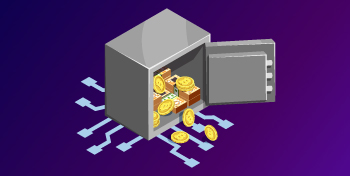In long-term prospective, gold has maintained its purchasing power against other currencies. In this respect, its millennial track record speaks for itself. But Bitcoin also promises a lot.
Gold or Cue ball: all the pros and cons
The ups and downs of gold pale in comparison to the wild volatility that Bitcoin has shown over the past decade. Simply put, bitcoin’s volatility is orders of magnitude higher than gold’s. This complicates the situation with Bitcoin as a stable store of wealth and a reliable medium of exchange.
Bitcoin is easier to liquidate
This point is related to liquidity, but not quite so. “Liquidation” in this context means simply selling.
With the advent of e-Commerce in financial markets, liquidating a gold position has become much easier than in the past. However, only paper-based instruments such as gold ETFs or gold futures contracts enjoy this advantage.
Indeed, there are cases when trading in electronic gold is closed. Obviously, this is also true for ordinary sites where physical gold is sold, which cannot be liquidated with a few keystrokes. It really takes advantage of an almost universal market where you can confidently sell no matter what country you are in.
Moreover, even during normal business hours, you will have to wait for your gold to be analyzed, i.e. smelted and analyzed for purity and authenticity, if you are selling a common bullion product.
Cryptocurrencies, on the other hand, can take full advantage of electronic liquidation. Bitcoin and its imitators were designed specifically for digital transactions. These cryptocurrencies by their nature inhabit the electronic world.
Thus, you can sell your cryptocurrency for another currency without leaving your home computer or smartphone.
The gold market has perfect liquidity

It will be useful to start by defining liquidity: essentially, how easily an asset can be bought or sold without affecting its market price.
This is a non-trivial consideration. Poor liquidity means that you may have to agree to sell something for much less than it should cost.
Bitcoin has experienced quite low liquidity from time to time. This is partly due to the delay in transaction speed during market downtime: prices can jump or fall sharply in the interim hours. Yes, sometimes transactions take hours to complete.
It is also true that large transactions tend to strongly affect the price of BTC, because trading volumes were relatively small under normal conditions. There were even revelations that the vast majority (perhaps 95%) of the reported volume was inflated by non-competitive trading models to create the appearance of greater liquidity.
Another problem is the large discrepancies between prices on different crypto exchanges. In a liquid market, there should be virtually no discrepancy between the price of the same asset traded on different platforms or platforms.
The gold market contrasts with its extremely high liquidity. Perhaps the only more liquid market in the world is US Treasury bonds.
Daily gold trading volumes are consistently high. Of course, you can also buy and sell physical gold all over the world, no matter how unreliable your WiFi connection is. Perhaps most important in terms of the Gold-to-Bitcoin ratio is that gold has abundant earth reserves, and most of this precious metal is eventually melted down and processed, rather than destroyed.
Usefulness as a hedge

Bitcoin is an effective means of protecting against disruptions in the broader markets.
This does have a logical argument. Not only is bitcoin widely regarded as an “alternative” asset, but it has been associated with innovation and revolution since its inception.
However, asset prices over the past two years have strongly correlated with stock prices. This model of following the stock market significantly reduces the usefulness of Bitcoin as a hedge. In short, it contradicts the purpose.
Hedging against market downturns, high inflation, and uncertainty is what works best for gold. This is an ideal barrier during economic shocks.
One of the biggest advantages that work in this regard for gold is that it is an uncorrelated asset. This means that its prices do not tend to move in the same direction as other assets.
The only strong correlation is with currencies: the price of gold can rise or fall depending on the purchasing power of the currency in which it is measured. This dynamic is especially true for the US dollar, the world’s reserve currency.
Since this relationship with Fiat currencies is essentially an inverse (or negative) correlation, gold has tended to resist the effects of inflation (in terms of purchasing power) throughout history.
Value as an asset
Investors, of course, are always interested in their return on investment. Despite oversimplification, this is undoubtedly the most basic measure of investment performance. Everyone wants to know: how much profit can I get from my investment?
Gold prices have generally risen and kept pace with inflation throughout history. This property is preserved for precious metals in the long term, which is not the case for Fiat currencies.
The value of gold as an investment is also supported by demand from various industries, as well as the economic realities of the gold mining sector.
By comparison, it should be recognized that Bitcoin has increased dramatically in price over the first decade of its life.
In fact, the price of BTC literally experienced exponential growth until a large-scale price correction in late 2018. If you reduce the time horizon by just a few years, bitcoin is up about 5,000% compared to when it was trading around $ 100 five years ago.
Bitcoin’s future potential for profit is undeniable. Still, it’s definitely not an investment for the faint of heart.
Remember that the growth in the value of gold over time has for the most part been steady. Never has the price of it fallen by 80% over any period of time. Meanwhile, such extreme volatility has at times shaken the nascent Bitcoin community.
Ultimately, gold does not see the impressive gains or significant losses that the prices of the MTC were subjected to.
Counterparty risk

Because of the greater risk, Bitcoin offers greater financial rewards.
Volatility is not the only risk that investors face. There is also a constant risk of hacking your bitcoin wallet or freezing the accounts of one of the unregulated cryptocurrency exchanges.
But what is counterparty risk? This is the probability that the other party in the contract, transaction, or transaction will fail to meet its obligations, creating liability for the counterparty.
Counterparty risk affects almost all financial assets, but Bitcoin is a particularly instructive case. BTC has faced more than its fair share of fraud and risks in its short life as an asset. Since the first days of its existence, hundreds of millions of dollars in cryptocurrency have already been lost or stolen.
To be honest, this is a problem that is inherent in all cryptocurrencies and digital assets, not just BTC. However, counterparty risk has become a serious problem. Coins have been stolen or hacked with alarming frequency, and most crypto exchanges still go beyond the usual regulatory protections due to their decentralized structure.
Meanwhile, physical gold has zero counterparty risk. In fact, it is the only financial asset with this characteristic. If you own physical gold bullion, there is no chance that someone else will fail to meet their obligations.
This quality not only supports the case for the metal as a true hedge or safe haven, but the presence of counterparty obligations is a major blow to forms of “paper gold” such as gold ETFs or futures contracts. Each of these gold-related instruments relies on cash settlement rather than physical delivery of metals, exposing the investor to potential counterparty risks.
Securing a certain level of financial security
When discussing the structure of an investment portfolio, security is often overlooked. This is unfortunate, because investing involves many risks. Everyone should plan their risk appetite accordingly.
There are ways to reduce some of these risks. The safest way to own gold is in physical form, and the safest way to store it is in an insured vault.
Storage in a vault is actually a requirement for precious metals included in a Gold IRA. In general, dedicated storage is preferable to combined storage, where metals are treated equally or interchangeably, so the assets of all participants are mixed. Thanks to a dedicated (or separate) storage, items that you Deposit are stored separately from the assets of other depositors.
It goes without saying that investing in gold is like saving money, except for the risk of inflation or depreciation of Fiat currencies. There is a similar argument about Bitcoin’s inflationary advantages, although its track record is much shorter, and this claim becomes less certain if you push the time horizon further than 15-20 years.
The equivalent of a bitcoin vault is cold wallet storage. This means using offline storage, such as a USB drive or external hard drive, and securely protecting your digital wallet key (or password). If you lose or forget your private key, no one will manage to access your assets. Even you.
As long as you keep the key to your digital wallet, the security of your bitcoin account is very high.
The disadvantage of safe storage of gold is the payment of an annual (or quarterly) storage fee. However, unlike physical gold, any power or Internet outage will actually make your bitcoin wallet unavailable.
Conclusion
Although we have applied a fairly scientific approach to this issue and used the experience of experts both in the field of precious metals and in the field of cryptocurrencies, there are, of course, other comparisons that you could make for these assets. Depending on what you choose to compare, Bitcoin may look like a winner. However, we specifically focused on the qualities that could support or challenge Bitcoin’s arguments for the name “digital gold”.
Of course, it can be stated that if Bitcoin were truly “digital gold”, one would expect it to satisfy at least five to seven of these qualities. Obviously, gold works better for 8/10 categories and is a compelling alternative asset that is uniquely suited to the financial sector.
And let’s drop all calculations and forecasts, and look at the reality. When all the world markets (including gold and crypto) collapsed in March as a result of COVID-19, it was BTC, not gold, that first recovered, and proved to the whole world that it is an excellent hedging tool.
In the long run (the next 10-15 years), it will be interesting to see what path each of these asset classes will take.

